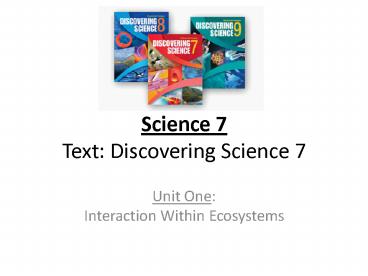Science 7 Text: Discovering Science 7 - PowerPoint PPT Presentation
1 / 24
Title:
Science 7 Text: Discovering Science 7
Description:
Science 7 Text: Discovering Science 7 Unit One: Interaction Within Ecosystems Chapter 1, An ecosystems is all the living and non-living things in a particular ... – PowerPoint PPT presentation
Number of Views:60
Avg rating:3.0/5.0
Title: Science 7 Text: Discovering Science 7
1
Science 7Text Discovering Science 7
- Unit OneInteraction Within Ecosystems
2
Chapter 1, An ecosystems is all the living and
non-living things in a particular place.
- Organisms living things within an ecosystems.
Ex. Worm, tree, whale, bird, dog, - Adaptations inherited characteristics which
help an organism to survive. Ex. Webbed feet,
feathers, scales, claws, - Habitat the particular place where an organism
lives. Ex. Pond, tree, field, soil, rotting log,
3
Types of Ecosystems inAtlantic Canada
- Coastlines and Oceans
- Freshwater Ecosystems
- (Rivers and Ponds)
- Arctic
- Forest
- Organisms survive in their ecosystems
according to their range of tolerance.
4
Abiotic Parts of an Ecosystem
- Light and Light Intensity
- Temperature
- Soil
- Air and Wind
- Water
5
Biotic Parts of An Ecosystems
- Virus
- Bacteria
- Algae
- Mammals
- Reptiles
- Amphibians
- Marsupials
- Raptors
- Crustaceans
- Plants
6
Levels of Organization
- Individual one
- Populations many individuals
- Community interactions of many species
- Ecosystems interactions of living and
non-living things - Each species in a community has a specific role
to place. These roles make up an ecological
niche, which includes where it lives, how it
obtains its food, and how it affects its
environment.
7
Chapter 2, Living and non-living things interact
in ecosystems.
8
Types of InteractionsSymbiosis
- Parasitism One organism benefits (parasite) and
the other is harmed (host). - Internal parasites. Ex. Tapeworm
- External parasites. Ex. Tick
- Mutualism Both partners benefits. Ex. Lichen
(Alga and fungus). - Commensalism One organism benefits and the
other neither benefits or is harmed. Ex.
Clownfish and anemone whales and barnacles.
9
10
Roles of Organisms in the Ecosystem
- Herbivores Plant eating. Ex. Moose, Rabbit,
- Carnivores Meat Eating. Ex. Owl, Spider,
- Omnivores Plant and meat eating. Ex. Bear,
mouse,
11
Roles of Organisms in the Ecosystem
- Consumers Organisms that get their food from
the biotic environment by eating (consuming)
other organisms. Ex. Fox eats mouse, shark eat
small fish, - Producers - Organisms that produce their own
food. Ex. Plants - Decomposers Scavengers organisms that live off
the dead, decaying or waste matter of other
organisms. Ex. Vulture, bacteria, fungus,
12
Keeping Food from RottingPreserving food
Preventing the Growth of Micro-Organisms
- Salting
- Smoking
- Pickling
- Freezing
- Vacuum packing
- Canning and Bottling
- Chemical Additives
- Drying
13
The Food Chain
14
Food Web
15
Nutrient Cycle
16
Chapter 3, Natural events and human activities
cause changes in ecosystems.
17
Succession
- The process by which a biological community
changes over time. Pioneer Species and Climax
Community
18
The Impact of People on Ecosystem
- Changing Ecosystem Deforestation, over-fishing,
land fill sites, oil spills, mining, acid rain,
Farming pesticide/herbicides and monoculture - Habitat Loss Urbanization (city building)
- Endangered and Extinct Species
- Introduced Species native species (fox and
polar bear) and introduced species (moose).
19
Endangered Species
20
Extinct Species
21
Atlantic Cod FisheryCauses of the Fishery Decline
- New fishing technology made it easier to find and
catch fish. - More demand for fish from the world market.
- Lack of conservation by governments.
- Unsustainable harvesting catching too much
fish. - Sustainable vs. Unsustainable
22
Fishing technology and Innovation
23
Monitoring and Managing Ecosystems
- Environmental monitoring helps detect and predict
changes in the habitats of organisms.
Environmental impact assessments using
data/information collected through short term and
long term monitoring can be used to make
appropriate decisions to prevent the
destruction of habitats and protect the lives
of wild species. - Baseline Data
- Permanent Plots
24
Unit OneSummary Review pages 96 - 97
- Students must realize that the textbook is the
main source of information, especially when
preparing for an end of unit test. - Worksheets, Guide Notes, PowerPoint
Presentations, etc are supplementary to the
textbook. - Students should be reviewing materials presented
in class on a continuous basis as part of a
regular home study schedule.































